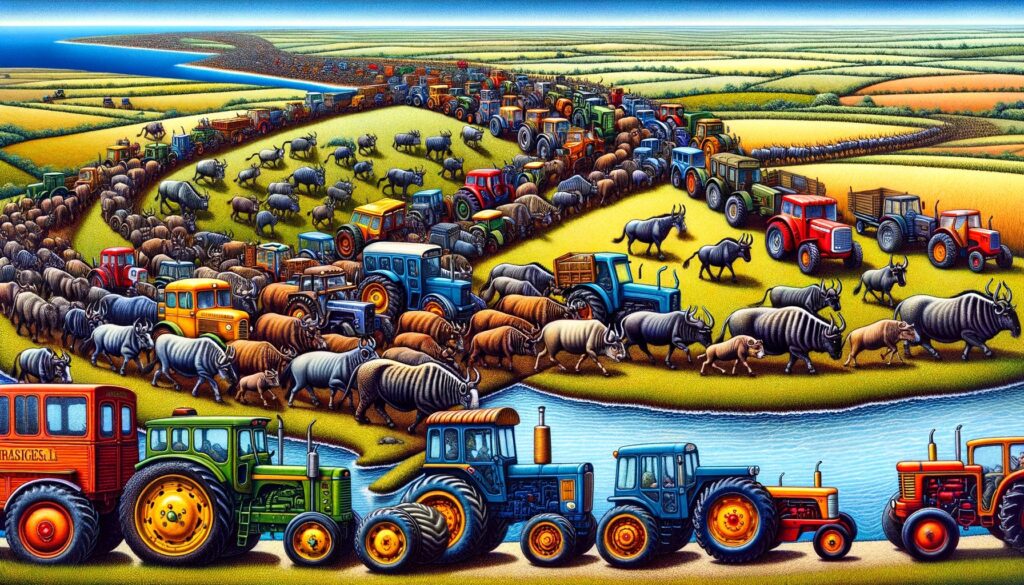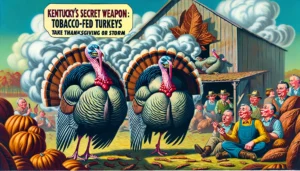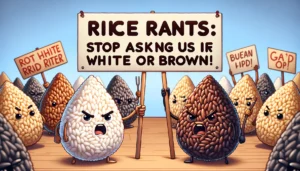
The Great Tractor Migration A vibrant and detailed close up illustration depicting The Great Tractor Migration a whimsical and imaginative scene where tractors are depicted as 2.webp.jpeg
Wichita Falls, TX — As the sun sets over the pastoral plains of Wichita County, one might witness a curious procession that rivals any nature documentary on the Great Wildebeest Migration. Only here, instead of sinew and hoof, there is steel and tire—this is ‘The Great Tractor Migration,’ a spectacle of mechanical beasts roaming the vast expanses of cropland.
To the uninitiated, the sight of John Deeres and Case IHs rolling en masse might suggest a robot uprising or perhaps a flash sale at the local machinery mart. But to the seasoned Wichita County denizen, it is but the annual shuffle of tractors as they transition from plowing to planting, and onward to the frenetic dance of harvest.
Unlike geese flying south for the winter, these tractors aren’t guided by magnetic fields or celestial navigation. No, their course is charted by the ebbs and flows of the seasons. As spring’s tender green shoots push through the soil, farmers unleash their tillers upon the land, cutting through winter’s hard crust like butter, preparing the stage for nature’s production. Here, a tractor isn’t just a tractor—it’s the leading actor in a drama that unfolds from seed to silo.

When the balmy breezes of summer start whispering through the wheat, it signals a whole new act in the agricultural ballet. Out come the sprayers, gracefully pirouetting from row to row, bestowing life-sustaining cocktails of nutrients and pest deterrence. In these parts, farmers don’t just water their crops—they choreograph a grand irrigation waltz, with sprinklers twirling in synchronized splendor, ensuring each parched plant gets its moment under the watery spotlight.
As the plot thickens towards the crescendo of fall harvest, the tractors don an array of hats: combines, corn heads, and grain carts. A cavalcade of equipment moves from field to field, as if engaged in a stately barn dance, rhythmically stripping the land of its bounty. These are the lead dancers in the agrarian corps de ballet, their powerful engines humming tunes of productivity.
The connection between these mechanical marvels and the fauna that roam the Serengeti is not lost on the locals, who view their equipment with the same reverence a shepherd has for their flock. Tractors, like antelope, are social creatures; they huddle together in the shed during the cold months, emerge in the warmth of spring, and proudly display their might during the fall.
However, it’s worth noting that unlike animal migrations, which are driven by instinct and survival, the tractor migration of Wichita County is a carefully orchestrated affair. As adept at reading their Farmer’s Almanac as they are at maneuvering a 16-row planter, farmers know the precise time to mobilize their fleets. The sequence is a choreographed piece that begins with preparing the beds for seeding and ends with the grain safely stored, ready to feed the masses.
It’s this agricultural acumen that makes the local farmers akin to wildlife rangers, guiding their charges through the seasonal cycle of farming. They know when to let their tractors graze over fields and when to let them rest. Each tractor plays a pivotal role, from the nimble sub-compact tractors perfect for mowing and light tilling, to the brawny row-crop tractors that make short work of pulling planters and grain carts.
It’s all in a day’s work for these unsung heroes of the heartland, where the tractor’s roar is as familiar as the morning crow of the rooster. Though no nature documentary has yet chronicled ‘The Great Tractor Migration,’ perhaps it’s high time they did. After all, in Wichita County, the tractors’ dance is as vital to the circle of life as any migration on the savanna.
And as the day wanes and the tractors return to their sheds, with engines cooling and headlights dimming, the farmers of Wichita County can rest easy, knowing their reliable herds of iron will be ready to rise with the dawn and begin the dance anew.
As we leave behind the rumbling engines and the sight of tractors in retreat, our next step will take us from the fields to the finesse of irrigation. Prepare to wade into the intricacies of ‘Dance of the Irrigation Sprinklers,’ where each spray and sprinkle is a step in an elaborate dance, keeping the rhythm of growth and life beating across Wichita County’s agricultural lands.
Our Reporters are Currently Following these Stories:
- Witnessed a herd of John Deere tractors migrating south for the winter, led by a majestic combine harvester playing the role of Mother Goose.
- Caught a farmer hitching a ride on the back of a tractor, claiming it was faster than his pickup truck and offered better company.
- Farmers seen practicing synchronized plowing routines in preparation for the upcoming Tractor Olympics.
- Spotted a group of rebellious tractors attempting to break free from their fields and embark on a road trip to Vegas.
- Witnessed a heated debate among tractor enthusiasts about whether red or green tractors make better migration leaders.
- Farmers spotted holding farewell ceremonies for their beloved tractors, complete with tearful speeches and heartfelt hugs.
- Confirmed reports of a tractor flash mob spontaneously breaking out in the middle of Main Street, causing traffic jams and bemused onlookers.
- Overheard a farmer negotiating with his tractor to return home after it ran off with a group of wild lawnmowers.
- Caught sight of a tractor migration checkpoint, where tractors were being inspected for proper migration papers and seed passports.
- Farmers observed offering bribes of freshly plowed fields and premium-grade fertilizer to entice tractors to stay for the planting season.
Originally posted 2018-12-05 21:47:12.
Originally Published at FarmerCowboy.com
2025-01-09 12:02:12
Karl Hoffman is a distinguished agriculturalist with over four decades of experience in sustainable farming practices. He holds a Ph.D. in Agronomy from Cornell University and has made significant contributions as a professor at Iowa State University. Hoffman’s groundbreaking research on integrated pest management and soil health has revolutionized modern agriculture. As a respected farm journalist, his column “Field Notes with Karl Hoffman” and his blog “The Modern Farmer” provide insightful, practical advice to a global audience. Hoffman’s work with the USDA and the United Nations FAO has enhanced food security worldwide. His awards include the USDA’s Distinguished Service Award and the World Food Prize, reflecting his profound impact on agriculture and sustainability.




